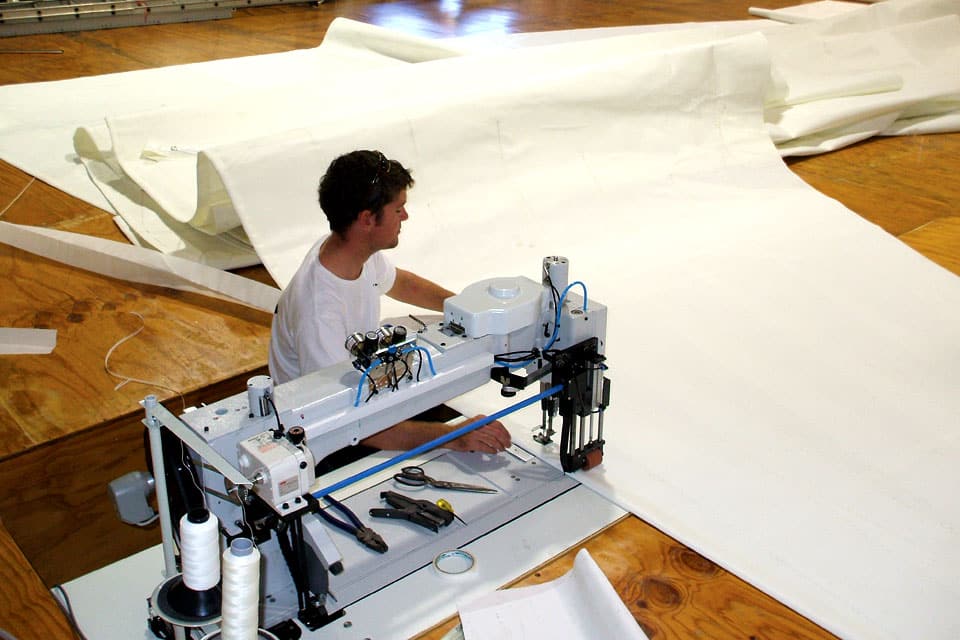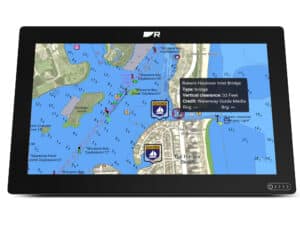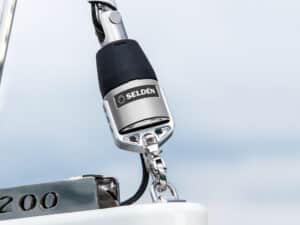
Ullman Sails Loft
Valiant 40
This boat has the perfect rig configuration for long distance offshore sailing. The cutter rig allows for a very balanced sail plan with appropriately engineered sails for each application. Slab reefing in the mainsail keeps things simple and reliable.
Mainsail
Conventional slab reefing is the most secure way to reduce sail as the wind increases. You are tucking in and shaking out reefs in the middle of the boat where there is deck space all around you and while it may require more effort than a furling mainsail you know that the system will not fail you.
We recommend for best economy using an Ullman Sails Endurance crosscut Dacron mainsail. (For all Dacron products we strongly recommend that you use fabrics available from recognized fabric manufacturers like Dimension Polyant, Contender, Challenge and Bainbridge. The same amount of work has to be done to build a sail from good fabric as it does for cheap fabric. The short term saving is false economy.) If the budget allows, this sail can also have a two-ply leech which reduces the overall weight of the sail, allowing it to perform better through a wider range of conditions. Full length battens up high stabilize and help support the fabric; regular length battens down low give you more adjustment to the sail shape.
With a less restricted budget, a FiberPath Cruise Enduro mainsail with double taffetas will provide great performance. For both excellent performance and the best durability of any cruising fabric, and if your budget allows, you would have to go for an Ullman Sails Voyager mainsail using Dimension Polyant’s Hydra Net cloth.
For a true blue water offshore inventory we recommend three reefs in the mainsail. Much of the heavy weather sailing will be done with two reefs in the mainsail which is a perfect combination as it lowers the center of effort of the sail plan and brings it toward the center of the boat creating better balance and maneuverability. The third reef will be deep and will serve as a storm mainsail in place of a trysail.
An Ullman Sails U-Stack is a very useful addition as it allows the sail to be contained by a set of lazy-jacks and the sail cover which makes up part of the system. At the very least a set of lazy-jacks are a must. We recommend slides on the luff so that the sail remains attached to the mast at all times and a loose foot to allow it to be eased in order to power up the sail in light wind conditions and also allows an easier fit for the U-Stack.
Endurance Yankee Genoa on the headstay
For economy we recommend that this power horse sail be made from a woven Dacron and engineered for a wind range from 5–25 knots. In order to lighten the sail for better low-wind range performance, we suggest two-plying the leech with a lighter Dacron for the low-load body area and a second ply Dacron in the high load area down the leech and along the foot of the sail. For better shape holding, if your budget allows, a FiberPath Enduro Cruise sail with double taffetas would be the answer and again a Voyager genoa using Hydra Net cloth if both shape holding and durability are required and fits within the budget. In less than five knots cruisers usually motor; over 25 knots it will be furled and you will use only the staysail.
We recommend a raised clew for a number of reasons. First this sail will work perfectly with the staysail when double-headsail reaching which is a perfect point of sail for passage making. The higher the clew, the less lead adjustment needed when the sail is used reefed. It also allows for good visibility under the sail and allows waves washing over the foredeck to go under the sail.
A foam or rope luff pad will enable a better sail shape when the sail is reefed and UV protection down the leech and along the foot will protect the sail when it’s rolled away.
Staysail
This will be the main heavy weather “workhorse” sail. It will need to be built crosscut from high aspect Dacron with a two ply leech, or radial cut with a split of heavier Dacron in the leech area. Ideally it should be a FiberPath Cruise Enduro sail using Twaron as the principal load-bearing fiber to endure the high leech loads. The fabric should also have taffetas on both sides.
We recommend that the staysail be hanked onto the inner forestay and stowed at the base of the stay in its own custom bag. Hanking on the sail also allows the use of leech battens which will further increase the life of the sail.
Additional Sails
Endurance Storm Jib
With the staysail on hanks, you can lower the sail leaving the stay free for the storm jib, which is critical for safety. We highly recommend that the storm jib be heavy orange Dacron. Hanks also allow the staysail to remain attached on the deck and in a UV bag. This will save the weight and cost of a UV strip on the sail.
Blue Line Asymmetrical Spinnaker
Nylite 90 will be adequate for the fabric, but going up in weight to Maxilite 150 will allow you enough time to get the sail down without destroying it if you are caught in a squall. Most cruisers only fly their spinnakers in perfect conditions where the extra weight of cloth will not hamper the boat’s performance. As much of the circumnavigation will be in steady trade winds, a reduced girth asymmetrical spinnaker will keep the boat moving in light winds and downwind. In light winds where a light fabric would help, most cruisers use the engine. The asymmetrical spinnaker must be set and doused with a spinnaker dousing sock.
For more downwind conditions you can ease the tack of the sail out which will cause it to project to windward and work better running at deeper angles. Otherwise the most balanced and easiest to manage will be the Yankee poled out to windward with a spinnaker pole.
This will be a more than adequate inventory – more sails might be nice, but they take up valuable storage space for very little commensurate performance gain.
Passport 545
The sail plan for the Passport 545 is not as ideal as the cutter rig on the Valiant, but with some careful thought and planning would be satisfactory for a circumnavigation. The in-mast furling system makes reducing sail easy, but the sail will have to be very carefully engineered to make it small enough to fit into the mast yet durable enough to handle a variety of wind conditions.
In-Mast Furling Mainsail
Cruisers should be aware that the in-mast furling system adds convenience at the cost of performance. In-mast furling mainsails will have only a fraction of the performance and life of a normal mainsail. In order to furl into the mast there will be no battens (we highly discourage vertical battens as they have had a history of hanging up on the mast slot and causing it to jam). No battens means no roach which will impact the performance and durability of the sail in a number of ways. First, the roach is the back of the mainsail that works in conjunction with the keel to provide lift. Second, without a roach there are higher loads on the leech as the load travels directly from the clew to the head of the sail without the advantage of it being disbursed over a wider area that would be provided by the roach. To further compound this, the in-mast system has limited space and therefore an under spec weight of cloth is used in order for the sail to fit inside. Finally, the sail is usually designed flatter to fit in the mast and with restrictions on desired shape, the sail is likely to be lacking in performance.
Because this is a high aspect sail we recommend that if using an Ullman Sails Endurance Dacron mainsail, a radial cut with a split having heavier cloth in the leech is important. A better solution would be the Ullman Sails Voyager Series Hydra Net option which can be engineered as strong as a Dacron sail yet will be lighter and fit more easily into the mast cavity.
Roller Furling Reaching Sail
To achieve the strength and yet retain the light weight necessary for this type of sail, a laminate is ideal. Either FiberPath or one of the standard off-the-roll laminates would do. This is a useful sail to have in that it is easy to set and douse with the furler, but because it’s set on a furler the sail cannot be too full and therefore its useful range is limited. For light air reaching it will be a power horse sail; for downwind sailing we recommend an asymmetrical spinnaker and dousing sock.
Solent Furling Headsail
This is not an ideal sail for passage making especially if it’s self-tacking. You will want to use this sail partially reefed as the wind builds, but if you are not able to move the lead forward to take into account the new configuration of the sail, you will end up with the leech twisting open and the sail becoming quite ineffective.
A boat like this with a small non-overlapping headsail relies heavily on the headsail to do its job properly. This is a very high aspect sail with heavy leech loads. Because of these loads, and because you measure the life of a sail by how long it retains an aerodynamic shape and not simply how long it holds together, we suggest an investment in a laminate fabric. FiberPath Cruise Enduro using Twaron and double taffetas will provide the shape holding that this sail needs and being non-overlapping, will have great longevity. The fabric must have UV-coated taffetas to add overall durability to the sail. Alternatively a radial cut Endurance Dacron sail will work but will not be as durable as the laminate over an entire circumnavigation.
Additional Sails
The inventory of three sails is not adequate for passage making. It’s easy to change gears between the two headsails but the range is limited, especially downwind and most importantly in gale force conditions. We recommend a Blue Line asymmetrical spinnaker in a dousing sock for downwind sailing, and a storm jib as well as a trysail. Where a third reef in a slab reefed mainsail can be deep enough to serve as a heavy weather sail on the Valiant, a reefed mainsail on the Passport is not a storm mainsail. The crew will need to install a separate trysail track and carry a trysail, which will also unfortunately take up space below decks.
We recommend adding a separate stay for the storm jib midway between the base of the mast and the tack of the Solent. The stay can be removed at the base and lashed to the mast when not in use, but it’s important that the storm jib be set on its own stay and attached with hanks. In order for the stay to be tight enough we suggest adding an over-center lever or some kind of quick tensioning turn buckle that is easy to attach in a building breeze.
Ullman Sails








